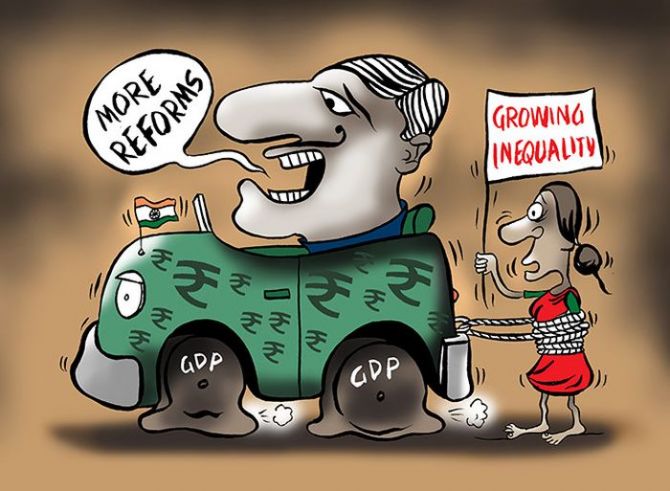A new study shows that the bottom half of the population enjoyed only 15 per cent of national income in 2013-14, down sharply from 24 per cent in the early 1980s.
And, while average incomes over this period had not even doubled, the top 1 per cent of the population saw incomes increase more than eight-fold, says T N Ninan.
Illustration: Uttam Ghosh/Rediff.com

The sharp criticism that has confronted the Narendra Modi government in the wake of slower growth of the gross domestic product makes it clear that the vocal public has bought the idea of gross domestic product growth being central to the national purpose.
What is equally instructive is the lack of debate that has flowed from a recent paper showing sharply growing inequality.
Thomas Piketty (celebrated author of Capital in the Twenty-First Century) and co-author Lucas Chancel have produced a provocatively titled monograph, From British Raj to Billionaire Raj?
Released a couple of months ago, it says that the rich pocketed almost all of the benefits of the post-reform years, indeed from the early 1980s.
Consequently, the bottom half of the population enjoyed only 15 per cent of national income in 2013-14, down sharply from 24 per cent in the early 1980s. And, while average incomes over this period had not even doubled, the top 1 per cent of the population saw incomes increase more than eight-fold.
Short point: inequality increased dramatically through the reform years, whereas it had been coming down for three decades till the early 1980s (when, as everyone knows, GDP growth was slow).
Chancel and Piketty make it a point to draw attention to the shift of economic policy that began at the point of transition from one period to the next, from government-ownership and heavy taxation to lower taxation and more market- and private sector-driven policies.
Though they don't imply cause and effect, it would be hard to argue against the proposition that those in a position to better enjoy the benefits of faster economic growth were the relatively well off.
That is not, however, to argue the contrary point: that the poor would have benefited from a continuation of the earlier set of dirigiste policies.
Chancel and Piketty's figures show that, when it came to income growth, the bottom half of the population did as well or badly in the two periods of about three decades each (1951-80 and 1980-2014): income growth of 87 per cent in the first period and 89 per cent in the second. So the poor were not worse off in absolute terms; they were however much worse off in relative terms.
If there were to be serious debate about the causes of growing inequality, and possible solutions, attention would have to focus on issues that Chancel and Piketty do not raise, such as the possible role of restrictive labour policies, which were tightened in the early 1980s, and the deeply unequal access to proper education and healthcare.
There would have to be further debate about introducing a minimum income support programme for the poor, as well as the wisdom of having scrapped altogether the long-term capital gains tax on shares and the abolition of the estate duty.
If every other form of long-term capital gain is taxed, why not shares -- at a modest rate, so as to avoid sending the market into a tailspin? And do we really want to be Trumpian on the estate duty?
Chancel and Piketty use individual adult income levels to suggest that only the top 10 per cent constitutes the Indian middle class. That is because they look at individuals, not households (which are the spending unit).
In 2013-14 there were 778 million adult individuals but only about 260 million families. If you use a straight ratio of three adults per family, then family income is typically three times what our co-authors say is individual income.
The threshold income level to belong to the top 10 per cent in 2013-14 was Rs 16,000 per month for an individual. A family with three adults would have had thrice that income (Rs 48,000), which after adjusting for growth during the last five years would be in the region of Rs 70,000.
In reality, a family at even half that income level has basic amenities such as a refrigerator and cooking gas, a TV set and possibly a motorcycle or scooter. India's consumption boom would simply not have happened if the middle class was no more than 25 million families.











